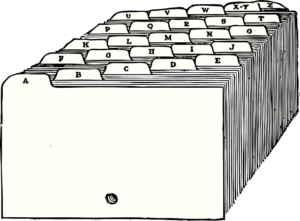There are two ways of producing a bibliography. You can either produce a bibliography manually by listing the entries of the bibliography or produce it automatically using the BibTeX program of LaTeX. Both types are detailed below.
1. Manually creating bibliography
If you are writing only one or two documents and aren’t planning on writing more on the same subject for a long time, you might not want to waste time creating a database of references you are never going to use. In this case, you should consider using the basic and simple bibliography support that is embedded within LaTeX. LaTeX provides an environment called the bibliography that you have to use where you want the bibliography; that usually means at the very end of your document, just before the \end{document} command. Here is a practical example:
begin{thebibliography}{}
\bibitem{JayakumarSulthan13}
Jayakumar, G. D. S., and Sulthan, A,
\emph{Heteroscedasticity in survey data and Model selection based on WHQIC},
Journal of Reliability and Statistical Studies,
6(2),
2013.
\end{thebibliography}
1.1 Output of the manual method
References
[1] Jayakumar, G. D. S., and Sulthan, A, Heteroscedasticity in survey data and Model selection based on WHQIC, Journal of Reliability and Statistical Studies, 6(2), 2013.
1.2 Citation
To actually cite a given document is very easy. Go to the point where you want the citation to appear, and use the following:\cite{citekey}, where the cite key is that of the bibitem you wish to cite. Cite key in the above example isJayakumarSulthan13When LaTeXprocesses the document, the citation will be cross-referenced with the bibitems and replaced with the appropriate number citation. The advantage here is that LaTeX looks after the numbering for you. If it were totally manual, then adding or removing a reference would be a real chore, as you would have to re-number all the citations by hand.
2. Bibliography – Automatically Using BibTeX
2.1 Why should you use BibTeX?
There are some difficulties of manually creating the bibliography:
•It is difficult to make entries consistent, i.e. variations in the use of full forenames versus abbreviations, italicization, or quoting of titles, spelling, etc
•A bibliography laid out in one style (e.g., alphabetic by author and year) is extremely difficult to convert to another (e.g, numeric citation order) if requested.
•It is difficult to maintain one large database of bibliographic references that can be reused in different documents.
•It is difficult to manage to sort manually, whereas, some bibliography styles sort entries in alphabetical order automatically.
Authors and researchers often find that they refer to the same set of papers in most of their publications. Thus, it is very useful to create a bibliography database and to use the database from one work to the next. A database is possible with the BibTeX program supplied by LaTeX. The information about the various publications is stored in one or more files with the extension of .bib. For each publication, there is a cite key that identifies it, which may be used in the text to refer to it. This kind of file is called a bibliography database.
2.2 Bibliography Database
A BibTeX database is stored as a .bib file. It is a plain text file, and so can be viewed and edited easily. The structure of the file is also quite simple. An example of a BibTeX entry:
@article{jayakumarsulthan2014,
title={EXACT DISTRIBUTION OF HAT VALUES AND IDENTIFICATIONOF LEVERAGE POINTS},
author={Jayakumar, GS David Sam and Sulthan, A},
journal={Journal of Reliability and Statistical Studies},
volume={7},
number={1},
year={2014}}
Each entry begins with the declaration of the reference type, in the form [email protected] knows of practically all types you can think of, common ones are: book, article, and for papers presented at conferences, there is in proceedings. In this example, I have referred to an article within a journal. After the type, you must have a left curly brace { to signify the beginning of the reference attributes. The first one follows immediately after the brace, which is the citation key, or the BibTeX key. This key must be unique for all entries in your bibliography. It is this identifier that you will use within your document to cross-reference it to this entry. It is up to you as to how you wish to label each reference, but there is a loose standard in which you use the author’s surname, followed by the year of publication. Next, it should be clear that what follows are the relevant fields and data for that particular reference. The field names on the left are BibTeX keywords. They are followed by an equals sign (=) where the value for that field is then placed. BibTeX expects you to explicitly label the beginning and end of each value. You can use curly braces{,}.
2.3 Bibliography Style
A bibliography style has to be chosen. The bibliography style can be declared with\bibliography{style}command, which may be issued anywhere after the preamble. one of common style is plain.bst. It is a part of the LaTeX package; so you no need to download it.
Example
A bibliography database file called mybib.bib is created as a sample, and it is given below.
@article{Hat12,
title={EXACT DISTRIBUTION OF HAT VALUES AND IDENTIFICATIONOF LEVERAGE POINTS},
author={Jayakumar, GS David Sam and Sulthan, A},
journal={Journal of Reliability and Statistical Studies},
volume={7},
number={1},
year={2014}
}
@article{Stress13,
title={Stress Symptoms: Structural Equation Modelling.},
author={David Sam Jayakumar, GS and Sulthan, A},
journal={SCMS Journal of Indian Management},
volume={10},
number={3},
year={2013}
}
Use the environment mentioned below and also cite the references in text using \cite{} (inside the braces type the cite key)
\bibliographystyle{plain}
\bibliography{mybib}




